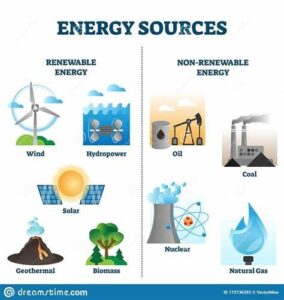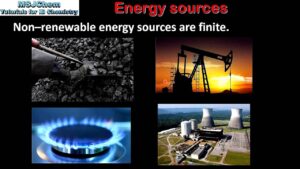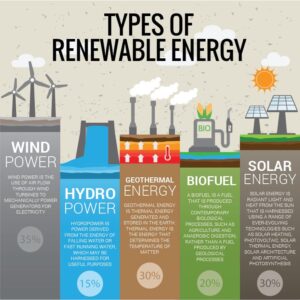Non-Renewable or finite resources are the natural energy sources that cannot be readily replaced by natural processes at a pace quick enough to keep up with their consumption. There are four major types of non-renewable resources: petroleum oil, natural gas, coal, and nuclear energy. Petroleum oil, natural gas, and coal are collectively called fossil fuels. Fossil fuels form under the Earth surface due to the fossilization and carbonation (pressure and heat) of dead plants and animals over millions of years.

Renewable resources are the energy sources that are derived from natural sources that replenish at a higher rate than their consumption rate. Thus, they practically never run out or get exhausted. Additionally, unlike fossil fuels, they produce clean energy which means less pollution and greenhouse gas emissions which contribute to climate change and global warming. Resources such as wood and timber when sustainably harvested are renewable sources of energy. Energy sources that are most abundant and freely available such as solar, hydro, tidal, wind, geothermal, and biomass that are used to power energy conversion systems are the clean renewable resources.
Globally, throughout the history, energy sources that have been used by mankind have evolved over time. The transition occurred from the usage of wood prior to the nineteenth century to adopting to the usage of non-renewable resources such as fossil fuels, petroleum, and coal which are still the dominant sources of energy even today. However, the Earth has a limited supply of these non-renewable resources. Recently, the usage of renewable resources has been developed, established, and is gaining popularity. According to the Global Environmental Protection studies, 11 percent of the energy consumption comes from renewable resources in recent years.
Let us discuss about individual types of non-renewable resources:
• Crude petroleum oil is a liquid fossil fuel that is mostly used to produce gasoline (petrol) and diesel fuel for vehicles, and for the manufacturing of plastics. It is found in rocks below Earth’s surface and is pumped out through oil wells.
• Natural gas is widely used for cooking and for heating houses. It consists mostly of methane and is found near oil deposits below Earth’s surface. Natural gas can be pumped out through the same wells used for extracting crude oil.
• Coal is a solid fossil fuel that is used for heating houses and generating power in thermal power plants. It is found in fossilized swamps that have been buried beneath layers of sediment. Since coal is solid, it cannot be extracted in the same manner as crude oil or natural gas; it must be dug up from the ground.
• Nuclear energy comes from radioactive elements, mainly uranium, which is extracted from mined ore and then refined into fuel.

Unfortunately, human society is dependent on non-renewable resources as its primary source of energy. Till date, approximately 80 percent of the total amount of energy globally used comes from fossil fuels. We depend on fossil fuels because they are energy-rich and relatively cheap to extract and process to produce power. However, a major problem with fossil fuels, aside from their being in limited supply, is that their combustion releases toxic gases like carbon dioxide and carbon monoxide into the atmosphere. Rising levels of heat-trapping carbon dioxide in the atmosphere is the main cause of global warming. These emissions cause environmental pollution and ecological damage.
Let us further discuss about individual types of renewable resources:
• Biomass refers to the organic material from plants or animals. This includes wood, sewage, and ethanol (which comes from corn or other plants). Biomass can be used as a source of energy because this organic material has absorbed energy from the Sun. This energy is, in turn, released as heat energy through combustion.
• Hydro Power is one of the renewable resources that has been used for thousands of years. Today, all major cities throughout the world use large amount of hydroelectricity. In hydroelectric power plants, the mechanical energy from flowing water of rivers and streams is used to turn heavy turbines to power a generator to generate electricity.
• Tidal Power is generated by tapping the energy from tides and strong currents of sea and ocean waters. Energy gets released as the tidal currents pass through the constrictions and turbines that are set up to harvest gravitational interaction of ocean waters.
• Geothermal Energy comes from the heat generated under the surface of the Earth’s core. Geothermal reservoirs can be found at tectonic plate boundaries near active volcanic or deep underground locations. Geothermal energy can be harnessed by drilling wells to pump hot water or steam to a power plant. This energy is then used for heating and electricity.
• Wind Energy generates electricity by turning wind turbines. The wind pushes the turbine blades and a generator converts this mechanical energy into electricity. This electricity can supply power to houses and other buildings and it can even be stored in the power grid.
• Solar Energy is the radiation from the Sun that is used as a power source. Photovoltaic cells are used to convert this solar energy into electricity. Individually, these cells can only generate enough energy to power a calculator. However, when combined to create solar panels or even larger arrays, these cells provide much more electricity.

In view of recent environmental crisis and health hazards, some of the factors that we need to keep in mind while choosing the energy resources are:
• In the perspective of energy resources, there is always the question of sustainability.
• It is important that resources provide enough energy to meet our requirements such as to heat or air condition our houses, power our cities, and run our automobiles.
• However, it is also important to consider whether these resources can be used for long term without exhausting the sources and polluting the environment.
• Natural resources that can largely present localized replenishment that can occur within time frames meaningful to humans.
• There are some challenges associated with the usage of renewable resources. For instance, renewable energy can be less reliable than non-renewable energy owing to seasonal or even daily changes in the amount of energy produced at a given point of time and location.
However, scientists are continually addressing these challenges, working to improve feasibility and reliability of renewable resources. Searching for the right method of using renewable resources is a task that is growing ever more important as the Earth’s supply of non-renewable resources continues to dwindle. Converting to renewable energy will not only better sustain the world’s rapidly growing population, but it will also provide a cleaner, healthier environment for the generations to come.
